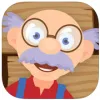Take a look inside 5 images
Grandpa's Workshop
Pros: Grandpa gives lots of positive encouragement, games are nicely designed, and (most) have good learning content.
Cons: Random game cycling without a common thread makes coverage of learning content feel superficial.
Bottom Line: An appealing package of simple, engaging games for light practice with basic math skills.
Kids can play individually for extra practice with some basic math skills. Little instruction is offered, so teachers will have to cover the concepts in class or let kids learn through trial and error. There's no way for multiple kids to play at their own pace on the same device, so have one kid cycle through to build a clubhouse, and then start over with the next kid -- or have each kid choose a different clubhouse feature.
A better plan would be to use the game's theme as a springboard for hands-on learning extensions in the classroom or at home. Talk about grandparents, have kids write or tell about their relationship with their grandparents (or aunts, uncles, extended family, etc.), and then encourage kids to do a project at home with their special person. Or you might use the construction theme to get kids involved in a classroom building project. Design and build a new bookshelf or cardboard castle. Use tools, measure, cut, put together, paint, and more (with close adult supervision, of course).
In Grandpa's Workshop, kids help Grandpa with his building projects. Kids endlessly cycle through seven games -- some quiz-like, some not -- each focusing on different learning content. Most games involve early math skills, like numbers and counting (e.g., choose the jar with the requested number of screws), measurement (use a measuring tape to measure wooden boards), or fractions (e.g., cut wooden boards into halves). Kids also paint finished projects, practice tool vocabulary, and put together puzzles. Videos showing building techniques (using a level, laying bricks, cutting with a jigsaw), and breaks to choose pieces for a customized clubhouse (foundation, roof, windows, and clubhouse sign) are interspersed throughout the game cycle. In Settings, adults can choose which games to include or exclude.
Kids naturally love helping adults do grown-up things, and they often have a special relationship with their grandparents. So the premise of getting kids working with (virtual) grandparents is a great idea. Simple games and clean graphics and design make play accessible to most kids.
The learning experience would be so much more rewarding if games had more depth and/or helpful hints and advice (although there is one nice hint for the measuring game). The experience would improve most dramatically, however, with some sense of coherence. Why not help grandpa actually build something? Measure and cut boards, count screws, put the pieces together in the correct way, hand over the right tools, choose a paint color, and -- Voila! -- you've made a bookshelf. Without this common thread and logical order, games feel disjointed, superficial, and even confusing (why does grandpa need four screws?). Natural stop points, progress trackers, and other enhanced features would also be nice.












